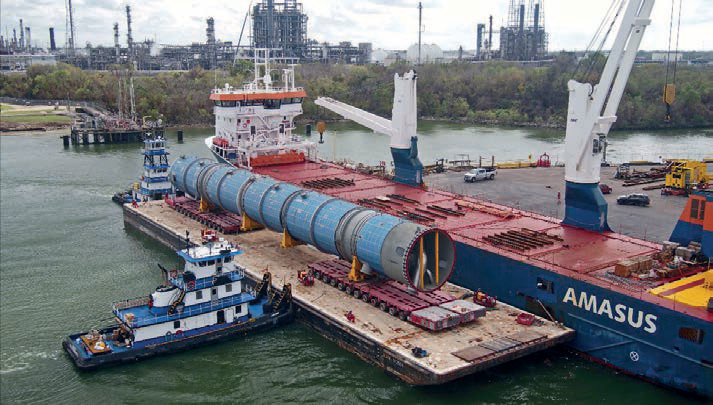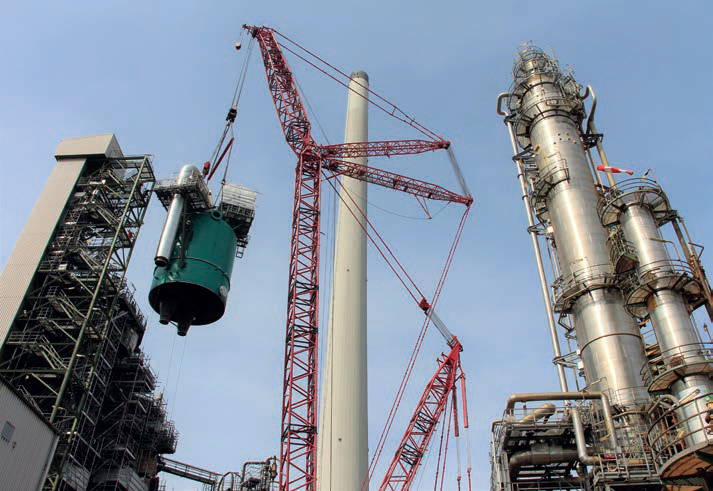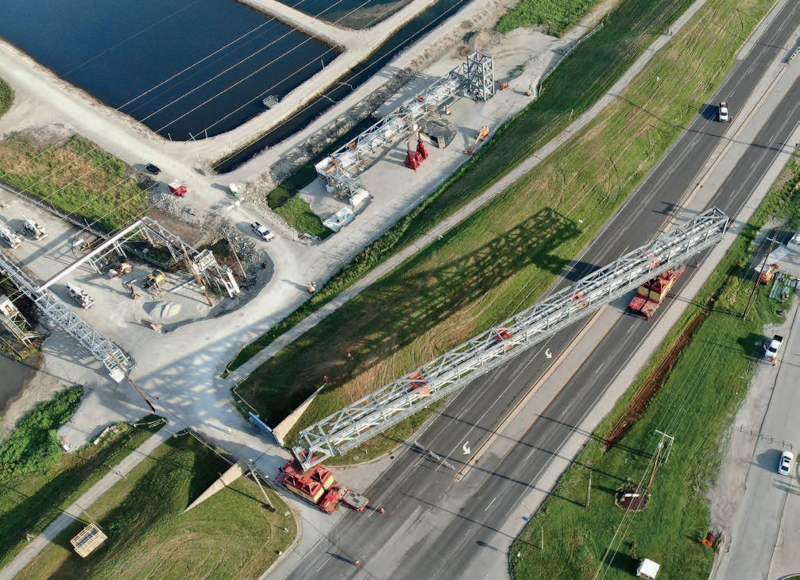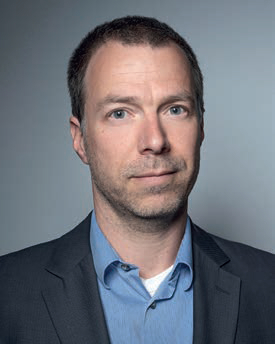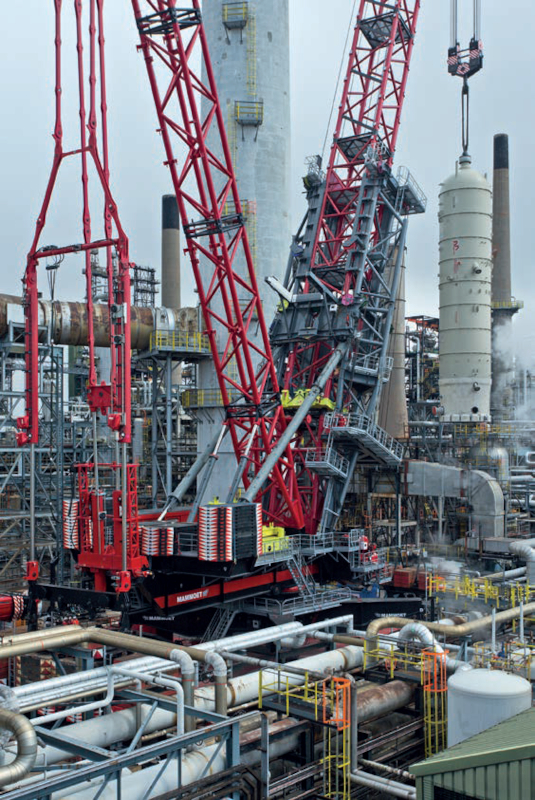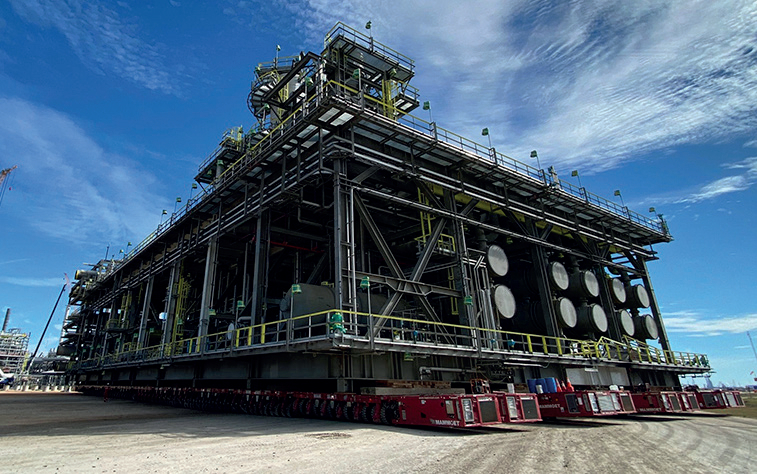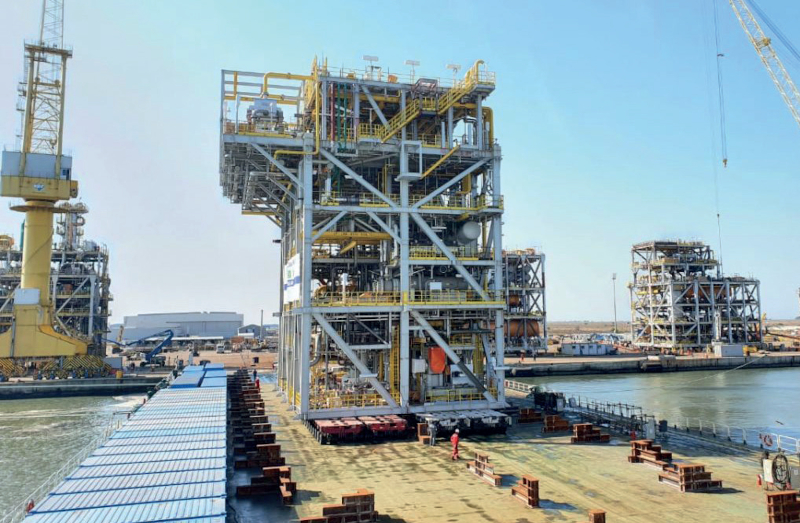Fuel for thought
25 May 2022Reinder de Haan, global segment lead for transport and logistics at Mammoet, speaks to Cranes Today about the company’s work in the oil and gas sector.
CT: WHEN DID YOU JOIN MAMMOET AND WHAT IS THE REMIT OF YOUR JOB?
RDH: I joined Mammoet back in November, 2013. I have a history in shipping – all sorts of shipping from chemical to dry cargo to oil to heavy lift – and at Mammoet my focus is on transport. My previous experience really complements the core activities of Mammoet. As you know, we specialise in cranes, trailers and, and special devices. We move the heaviest items in the world. I’ve found that my background in shipping, in particular, has been valuable because industrial developments around the world are often located in and around shorelines so there’s always this interface with barges, with ships, with trains, with our cranes, and with our trailers.
My first job was in the oil and gas industry, actually, with Shell Trading and Supply (STATCO) in London. So I’ve always had this desire to work in the industry. Then, by chance, I moved into the project market and that then led me to working at Mammoet.
WHAT SERVICES DOES MAMMOET PROVIDE TO COMPANIES OPERATING IN THE OIL AND GAS SECTOR?
In the project industry, items are usually produced somewhere else in the world so they need to be shipped, transported and then installed – so this is what we do: lifting, transporting, installing, and decommissioning. In this way, in the oil and gas industry especially, we are involved in the whole life cycle. This goes from conceptual design, particularly modularisation, to executing the plans – which involves transporting, lifting, installation. And when it comes to the end of the life cycle, we aid decommissioning with our cranes and transport solutions.
Obviously Mammoet is known for its cranes and transport solutions, and particularly for our larger cranes, but we do all types of work – both big and small. We have a special division, Conbit, which serves the offshore oil and gas industry by creating special lifting devices, for instance, for flare tip replacements. The flare tip is located high up so to replace it you either need a large offshore installation crane / installation vessel or, what we have done at Conbit, develop custom lifting plans and equipment based around very light equipment. So, as you see, we do all sorts.
OF THESE SERVICES, WHICH ARE CURRENTLY IN MOST DEMAND AND WHERE GLOBALLY?
Looking at the lifecycle of oil and gas assets you can break our work into two areas. On one hand there is the project market such as new build refineries. A good example of this would be the new Dos Bocas refinery in Mexico or the LNG Canada project. Then, at the other end of the scale but equally important there’s our maintenance work such as refinery shutdowns that require a large number of cranes while the refinery stops production for a short while.
You can see this pattern throughout Mammoet’s work, actually. We carry out the large projects with our big cranes whilst also serving our clients on a day-to- day basis, ensuring they have the right cranes at the right time.
To put this in perspective, we have a fleet of over 1200 cranes but the majority of these are actually in the 100 to 400 tonne range. They comprise mobile cranes that are used particularly for maintenance, while at the top end we have our 5,000 tonne capacity ring cranes that are primarily engaged in the project market.
And then we have our SPMTs, which Mammoet is particularly well known for. We have a lot of SPMTs at the moment, all around the world, and they are being used on both the large project jobs and for maintenance work thanks to their versatility.
HOW HAS OIL AND GAS WORK CHANGED OVER TIME? HAVE THE LOCATIONS YOU WORK IN OR THE TYPES OF SERVICES YOU PROVIDE CHANGED?
This really goes hand in hand with global development. The oil and gas industry was built in the USA and in Europe; that’s where the oldest refineries are. With economic development worldwide, however, population growth has demanded that these facilities also shift.
There are large refineries in India now, for example. In Nigeria the Dangote Refinery, which we helped build, has just come online. Then there’s the Dos Bocas refinery in Mexico, which I referenced earlier. What it comes down to is that developing countries require more hydrocarbons as they grow. The established refineries in Northwestern Europe serve their economies but upcoming economies need their own refineries, too. So, yes, there has been a corresponding shift in our activity.
At the same time there is a big push to limit greenhouse gas emissions which has resulted in greater demand for gas. And with recent developments in Europe, many European countries are now seeking to source their gas from other regions. This will have a direct effect on the demand of our services in the near future, too. But as a generalisation you can say that demand for our services geographically really mirrors the economic development of nations.
WHAT EQUIPMENT ARE YOU PRIMARILY USING WITHIN THE OIL AND GAS SECTOR?
As I outlined, our work is split between project work and maintenance work. And when you’re building facilities you need a huge amount of SPMTs and large cranes, especially with the refinery elements becoming bigger and heavier all the time. So a 5,000 tonne ring crane is now a normal piece of equipment for a building a new refinery.
At the same time, through our global branches, our mobile cranes are key for maintenance work. For this our more-agile all terrain cranes of 400, 500, even 600 tonne capacity are hugely important. The majority of our fleet is within this lower range.
And with the push for environmental change, legislation has become more stringent. We see refineries removing sulphur and that sort of thing. This in itself also means new equipment, often with higher lifting capacities, is being introduced into existing facilities. The difficulty is that, as the refinery has already been built, we need greater lifting capacity in a smaller area. This contradiction has led us to develop the FOCUS30 self-erecting crane which is a two-and-a-half thousand tonne-class crane yet it can build itself vertically. You only need a space of 35 by 35 metres to erect it. This is unheard of in the industry and it's been a huge success.
So, just to recap, SPMTs and large cranes are used for new builds, while smaller agile cranes are used for maintenance. And then there’s been the development of high capacity cranes and our vertically self erecting FOCUS30.
HAVE YOU DEVELOPED ANY SPECIAL TECHNIQUES SPECIFICALLY FOR OIL AND GAS WORK?
I return the FOCUS30 as we’re really proud of this crane, which has really been developed due to customer demand, where we saw the need to have a high capacity crane with a low ground bearing pressure that can self-erect in a very tight space.
The crane was introduced last year. Its first job was in the UK and it has now finished its third job – all with great success. With the last job we even shortened the construction schedule using the crane.
Another success has been in the USA by integrating jacking systems with SPMTs for moving pipe racks. Usually SPMTs move the pipe racks which are then jacked up. With this system we’ve integrated the jacking system into our SPMTs. This means you can lower construction height to one-and-a-half metres, whereas normally you'd have to jack the racks up first, leading to efficiency gains. These are just some examples of how we are constantly engaging with our clients to find the optimal way of doing things.
WHAT PARTICULAR CONSIDERATIONS NEED TO BE TAKEN INTO ACCOUNT WHEN WORKING IN THE OIL AND GAS SECTOR COMPARED TO OTHER SECTORS?
Oil and gas is characterised by its safety culture. It’s a subject close to my heart as my father was a safety engineer so I grew up hearing stories about the subject around the dinner table.
But a zero tolerance to accidents is key when working in the oil and gas sector. You know, a lot of times people say to me that lifting such big items must be exciting. Well, actually, it should not be exciting as this is when things go wrong. Everything should be pre-planned. The push for safety is such an important element and it needs constant attention.
That’s what makes working in this industry so interesting because you have to stop and think about everything that you are doing.
We work in live plants, in environments with hydrocarbons which are highly flammable. If a crane topples over it could have disastrous consequences so, yes, safety has been a key driver.
IS MAMMOET LOOKING TO EXPAND INTO ANY NEW GEOGRAPHICAL AREAS TO BETTER SERVE OIL AND GAS WORK?
We go where our clients go. We’ve seen a large push for new gas facilities driven by increasing adoption of Liquefied natural gas (LNG). So, for example, in the USA, LNG export facilities are already considering increasing their capacity. Even Australia is now looking to export its gas to Europe in the next couple of years. Mexico and Nigeria are good examples, too. And developments in Mozambique mean we will move with our clients.
And once these facilities have been built they need to be maintained and so we are there to serve them where we can. In this way there has been a slow but steady expansion of our branches. In the future Africa will certainly become more important, as we have seen with the Dangote Oil Refinery.
The world still needs hydrocarbons, for now and for the foreseeable future. We may have just reached peak oil but offshore exploration is still continuing.
Stepping away from the argument whether this is a good thing or not, I'm firm believer in the technical capabilities of humankind. I’m talking about things like carbon capture, which is another area which could become very important for us, and also the active removal of CO2. I think we will see that trend also developing and it will require equipment to be built. So, yes, we are expanding globally.
MODULAR COMPONENTS FOR REFINERIES ARE GETTING EVER BIGGER AND HEAVIER; DO YOU SEE THIS TREND CONTINUING?
About a month ago we delivered once of the largest pieces in around a year. It was for the Dos Bocas refinery in Mexico and weighed close to 2000 tonnes. It was lifted using a Jumbo heavy lift vessel which has a lifting capacity of 3000 tonnes. Before the Jumbo existed lifting a 2000 tonne piece was not possible. Prior to the year 2000, before these heavy lift vessels existed, you didn’t see many reactors shipped this way. What I’m saying is that industry and crane capacity go hand-in-hand.
Is there a limit? At the end of the day, yes, there is a theoretical limit but, well you may have seen on our website the conceptual designs for an 18,000 tonne crane; it's a huge beast. Why have we designed it? It’s a response to our clients demands for efficiency.
WITH THE GROWTH OF THE RENEWABLE ENERGY SECTOR, HAVE YOU NOTICED A DECLINE IN YOUR OIL AND GAS WORK?
The short answer is, no, not at all. Although there's a debate on whether or not we have reached peak oil yet or whether that will come in the next couple of years, it still means human society is fully dependant on hydrocarbons. In Europe and North America we may have reached peak capacity in our demand for oil but lots of developing nations still require it. The renewable industry, offshore wind in particular, is an addition.
What this means for us, with the wind industry in Europe gathering pace, is that the cranes which were typically designed for the oil and gas industry refineries are now being used long-term for load-out and load-in of heavy offshore wind components.
For instance, out of the seven ring cranes that we have, three are now dedicated to offshore wind; but we still need to serve our clients in the oil and gas industry. So, as a result, especially with our ring cranes, we are urging our customers to ensure that we are aware of their needs well in advance because there is a shortage of capacity at the moment. And we will see that for the foreseeable future. Offshore wind in America is only just starting. At the same time there is a huge push for more gas export terminals. Terminals that recently came on stream are already being considered for expansion. ExxonMobil's Baytown Refinery in Baytown, Texas, will continue for years to come. LNG Canada has just started.
So we see a definite increase in demand which might stabilise in the oil and gas sector and increase in the renewables sector – but as a complimentary service. Complimentary demand, I'd call it.
WHAT DOES THE FUTURE OF OIL AND GAS WORK HOLD?
We are arriving at a time of technological advances. Not only oil and gas but other industries, such as the chemical industry or plastics industry, where we see increasing modularisation of these facilities and also things like the reuse of plastics which is slowly but steadily gathering steam. And both these things are creating greater demand for our installation cranes, our SPMTs, our special devices.
Although ultimately we need to change our society and our industry, this will not happen by simply saying goodbye to the oil and gas industry; that will not happen for decades to come. What we do need to do, though, is learn how to reuse these molecules and that needs to be done on an industrial scale. So I see a bright future in that respect.
See our video interview with Reinder de Haan at: www.cranestodaymagazine.com/videos
